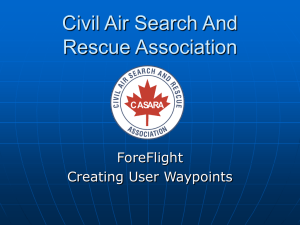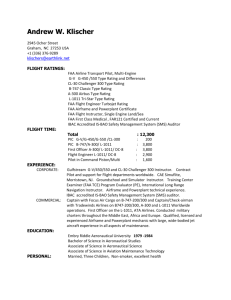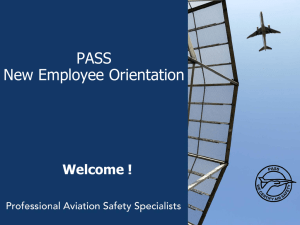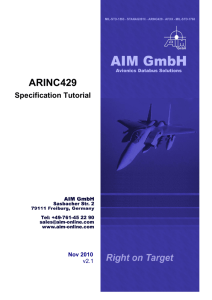Half_Degree_12_August_Meeting_Report_08272014_GROUP
advertisement
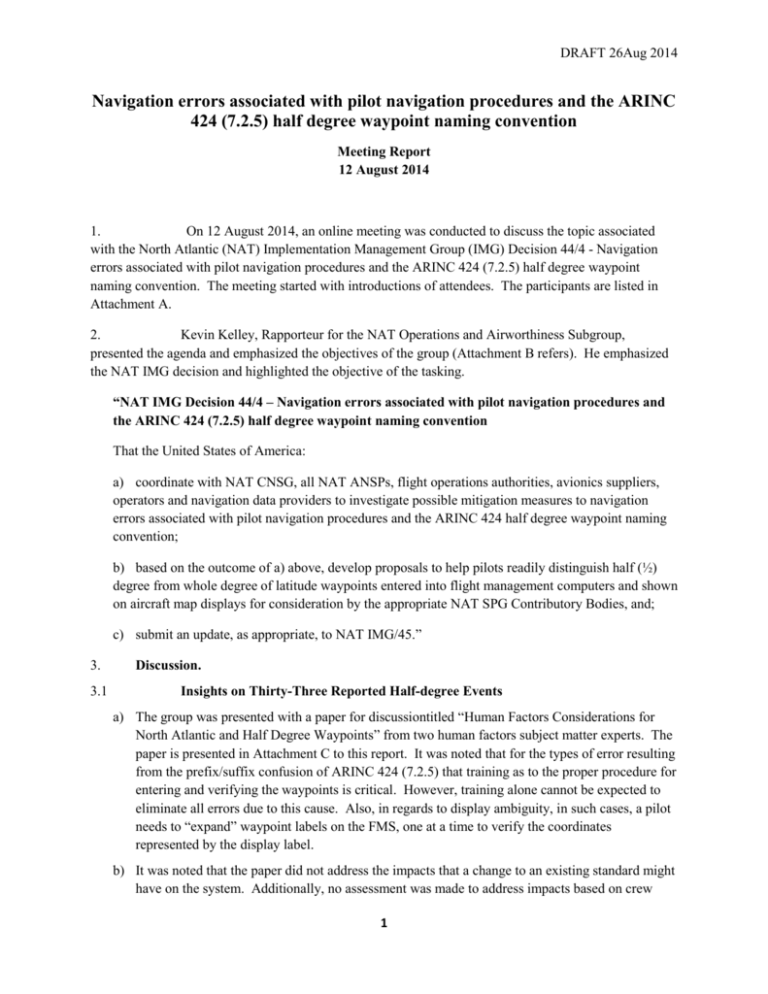
DRAFT 26Aug 2014 Navigation errors associated with pilot navigation procedures and the ARINC 424 (7.2.5) half degree waypoint naming convention Meeting Report 12 August 2014 1. On 12 August 2014, an online meeting was conducted to discuss the topic associated with the North Atlantic (NAT) Implementation Management Group (IMG) Decision 44/4 - Navigation errors associated with pilot navigation procedures and the ARINC 424 (7.2.5) half degree waypoint naming convention. The meeting started with introductions of attendees. The participants are listed in Attachment A. 2. Kevin Kelley, Rapporteur for the NAT Operations and Airworthiness Subgroup, presented the agenda and emphasized the objectives of the group (Attachment B refers). He emphasized the NAT IMG decision and highlighted the objective of the tasking. “NAT IMG Decision 44/4 – Navigation errors associated with pilot navigation procedures and the ARINC 424 (7.2.5) half degree waypoint naming convention That the United States of America: a) coordinate with NAT CNSG, all NAT ANSPs, flight operations authorities, avionics suppliers, operators and navigation data providers to investigate possible mitigation measures to navigation errors associated with pilot navigation procedures and the ARINC 424 half degree waypoint naming convention; b) based on the outcome of a) above, develop proposals to help pilots readily distinguish half (½) degree from whole degree of latitude waypoints entered into flight management computers and shown on aircraft map displays for consideration by the appropriate NAT SPG Contributory Bodies, and; c) submit an update, as appropriate, to NAT IMG/45.” 3. 3.1 Discussion. Insights on Thirty-Three Reported Half-degree Events a) The group was presented with a paper for discussiontitled “Human Factors Considerations for North Atlantic and Half Degree Waypoints” from two human factors subject matter experts. The paper is presented in Attachment C to this report. It was noted that for the types of error resulting from the prefix/suffix confusion of ARINC 424 (7.2.5) that training as to the proper procedure for entering and verifying the waypoints is critical. However, training alone cannot be expected to eliminate all errors due to this cause. Also, in regards to display ambiguity, in such cases, a pilot needs to “expand” waypoint labels on the FMS, one at a time to verify the coordinates represented by the display label. b) It was noted that the paper did not address the impacts that a change to an existing standard might have on the system. Additionally, no assessment was made to address impacts based on crew 1 DRAFT 26Aug 2014 training cycles. Similarly, the paper did not consider in benefits of expanded route clearances. It was noted that these factors would have to be the subject of an expanded study if the group decided to pursue this. c) 3.2 The group noted that in anticipation of the RLatSM implementation, an aeronautical navigation data base (NDBs) provider updated the 3 April navigation data bases to include 175 new ½degree latitude oceanic waypoints. This update to the NDBs was not properly coordinated with the Operators or the Air Navigation Service Providers (ANSPs). It was noted that the uncoordinated nature of this change to the current conduct of operations in the North Atlantic was a factor which deserves more mention in the root cause analysis of the lateral deviations, in particular whether awareness and/or training might have reduced or eliminated the lateral deviations. The draft analysis should be updated to reflect these points. Review of Possible Mitigations a) Generally speaking it was noted that the draft list in Attachment E was a good start as some possible mitigations. So that the group can identify those items that may be achievable in the near term and which items would be longer term fixes, timelines need to be established for those items that the group ultimately agrees upon. Some in the group felt entries on training on the ARINC 424 (7.2.5) standard and manual entry of oceanic waypoints should include expanded listings of advantages and disadvantages. b) Route Uplinks. The group noted that once fully established, autoload of route data would be very useful in reducing pilot waypoint insertion errors. Some of the subject matter experts noted that work was still needed to see this item fully implemented. The list of advantages and disadvantages for this item needed more input from the group. c) Removing the ARINC 424 Supplement 20. Paragraph 7.2.5 half-degree waypoints. Regarding this possible mitigation the group had good discussion. Some of the points that the group made were; that any changes to the current standard should be considered within a global context; that consideration needs to be given to the effects of all systems that would be impacted and any consideration of change should be harmonized accordingly; that the lateral deviation problem should be considered in light of the uncoordinated change to the navigation data base and the scope of the issue should be considered; that if no change to ARINC 424 is contemplated, the group should consider whether the use of the ½-degree waypoints should be prohibited? If this were decided, what additional safety analysis is needed for this; that impacts the use 5ANC would have on the system and how would these be implemented should be considered; and The group may determine that this proposed mitigation and its global nature make this mitigation beyond the scope of the IMG decision and should be considered by ICAO Montreal . 2 DRAFT 26Aug 2014 d) Training and Outreach. It was noted that this would be a factor no matter what mitigations would be recommended. IATA proposed that the group may want to review both the NAT Doc 007 and the Oceanic Bulletins to see if any improvements could be made related to the implementation of RLatSM. 3.3 Statements a) Jeff Miller of IATA made some remarks, and referred to an email, which is copied here: “In the short to midterm (RLATSM Phase 1), the IATA recommendation is: 1) All NAT Region stakeholders support the use of full LAT/LONG coordinates in an ½ degree lateral airspace design, 2) work to increase the awareness of GNEs causal factors, best practices and adherence to current procedures, 3) maximize utilization of current technology (CPDLC) to deliver oceanic clearances and reroutes. In the long term (RLATSM future implementation), the IATA recommendation is: 1) eliminate the “automation language” differences between FDPS and the aircraft systems, 2) develop a regional ½ degree named WPT (“5ANC”) implementation plan that would have global acceptability/harmonization, and 3) work toward an inclusive/collaborative process to include follow-up safety analysis (post step #2 above), stakeholder training of the new airspace environment, and 4) due consideration is taken of associated technical processes including, aircraft and FDPS uplink / downlink capability and limitations, FMS capability and limitations, operator flight planning automation systems, and changes to the oceanic Track Message, etc.” b) Mike Hynes of IFALPA likewise made some statements and followed them up with an email, which is pasted here: ”I’m hopeful this is supportive of the increased use of a technology solution (increased uplinks, and better naming or truncation formats) while recognizing the short term need to begin the trial and the longer term training, systems modification and global approval requirements. 1) A very limited number of one-half degree waypoints have existed globally for some time. The forthcoming wide-spread use of one-half degree waypoints will be a “new” process for all operators, flight crew and ANSPs, resulting in the development of modifications to various systems and a “new” training requirement for all parties. 2) Solutions must be globally adoptable, and common in all areas (i.e., the NAT solution should not differ from a Pacific solution). 3) Expand use of Route Uplinks by ANSPs and Operators for processing enroute ATC/ANSP clearances or clearance (track) changes, and operator requested re-routes to eliminate a potential source of error (flight crew manual entry of waypoints). 4) Use of the full thirteen-character latitude/longitude format for one-half degree waypoints provides a common, easily understood process for all flight crews, operators and ATC/ANSPs. 3 DRAFT 26Aug 2014 5) Waypoint display/naming/formatting differences (ARINC 424 naming conventions, truncation methods, etc.) between operator flight planning systems, aircraft flight management systems and ATC/ANSP track messages and systems should minimize the potential for waypoint confusion (i.e., minimize human factors hazards). 6) Operator and flight crew use of Oceanic waypoint and route verification procedures must continue to be strongly emphasized.” 4. Next Meeting. The next group meeting is scheduled for 4-5 September in Paris. Attachments A. List of Attendees B. Meeting Agenda C. Human Factors Considerations for North Atlantic and Half Degree Waypoints D. Results of Error Analysis (DRAFT) E. Possible Mitigation Measures (DRAFT) \ 4 DRAFT 26Aug 2014 ATTACHMENT A – List of Attendees John Kasten Roy Grimes Steve Smoot Karen Chiodini Kevin Kelley Steven Pinkerton Tom Kraft Marvin White David Maloy Jerry Bordeaux Kathy Abbott Edward Malloy Bob Gaul Cameron Crow Kelly Dillard Ekkehard Gutt Rich Stark Jeff Miller Mike Hynes Leifur Hákonarson Kyle Jermyn Christian Gruetter Noel Dwyer Luis Tojais Finlay Smith Tony Summers Tracy Lennertz ARINC Member of ICAO IFPP CSSI, Inc. CSSI, Inc. FAA FAA FAA FAA FAA FAA FAA FAA FAA Contractor Garmin Garmin Garmin IATA IATA IATA IFALPA ISAVIA Jeppesen Lido NAV Canada NAV Portugal UK NATS UK NATS Volpe A-1 John.Kasten@jeppesen.com RGrimes@cssiinc.com Steve.CTR.Smoot@faa.gov Karen.l.Chiodini@faa.gov kevin.c.kelley@faa.gov steven.pinkerton@faa.gov Tom.Kraft@faa.gov marvin.e.white@faa.gov david.maloy@faa.gov jerry.bordeaux@faa.gov kathy.abbott@faa.gov edward.ctr.molloy@faa.gov bob.gaul@garmin.com cameron.crow@garmin.com kelly.dillard@garmin.com ekkehard.gutt@emirates.com naked@mindspring.com millerj@iata.org mike.hynes@alpa.org leifur.hakonarson@isavia.is Kyle.Jermyn@jeppesen.com christian.gruetter@lhsystems.com Noel.Dwyer@navcanada.ca Luis.Tojais@nav.pt finlay.smith@nats.co.uk tony.summers@nats.co.uk Tracy.Lennertz@dot.gov DRAFT 26Aug 2014 ATTACHMENT B – Agenda Proposed agenda: 1. Welcome; Review of IMG Decision 44/4; Issues affecting pilot ability to “readily discern whole from half degree waypoints” 2. NAT ANSP Insights on 33 Reported Half Degree Events (Gander, Reykjavik, Shanwick, Santa Maria) a) Presentation of root cause questionnaires, each event b) Summary information/ additional comments 3. Human Factors Analysis of ½ Degree Environment (FAA Human Factors; Volpe Human Factors) 4. Review of Possible Solutions a) Expand Use of CPDLC Route Uplinks b) Remove Half Degree 424 7.2.5 Supp 20 Waypoints c) Remove outright (status quo) d) Publish 364 New 5-Alphanumeric Name Code Waypoints via Common-Language Aeronautical Information Circular e) Revise 424 7.2.5 Convention f) Training g) Modify Avionics 5. Face-to-Face Meeting Objectives 6. Meeting Report 7. Recommendations 8. Comments by Industry, Groups, & Regulators B-1 DRAFT 26Aug 2014 ATTACHMENT C - Human Factors Considerations for North Atlantic and Half Degree Waypoints Kim Cardosi, PhD US DOT/Volpe Center National Expert, Aviation Human Factors Kathy H. Abbott, PhD, FRAeS Federal Aviation Administration Chief Scientific and Technical Scientific Advisor, Flight Deck Human Factors Prefix/suffix confusion: The current ARINC 424 paragraph 7.2.5 naming convention employs a single discriminator, placement of the letter “N” as a prefix or a suffix to the four numbers which denote the latitude and longitude, to distinguish between whole degree of latitude waypoints and half degree of latitude waypoints. For example, “5940N” denotes N59°/W40°, whereas “N5940” denotes N59°30’/W40°. Training as to the proper procedure for entering and verifying the waypoints is critical. However, such errors would be expected to continue even with significant training and checking procedures in place for several reasons. First, it is a basic human factors principle that training is not an effective mitigation strategy for such ‘slips.’1 Second, such errors are difficult to capture and correct.2 Display ambiguity: Avionics that truncate or round the full coordinate values can display whole-degree waypoints and half-degree waypoints as identical. In such cases, a pilot needs to “expand” waypoint labels on the FMS, one at a time to verify the coordinates represented by the seven-character label. A format less susceptible to errors should be: compatible with CPDLC route uplinks, easily communicated between pilots and controllers (that is, entry into the FMS should be consistent with the way that the clearance is given). Additionally, discrepancies between the uplinked or manually-entered route and intended route should be easy for the pilot to identify. Note that the material discussed above is based on HF expertise and previous operational events. Analysis of the GNEs attributed to operations using half-degree waypoints still needs to be completed. 1 A slip is a type of error where the pilot meant to do the correct action but carried it out incorrectly. The half-degree waypoint issues could be considered one example of a larger set of difficulties in pilot interaction with the FMS. The larger set of issues is discussed in the Report of the PARC/CAST Flight Deck Automation Working Group http://www.faa.gov/aircraft/air_cert/design_approvals/human_factors/media/OUFPMS_Report.pdf. See paragraph 3.2.4.4: “The occurrence of FMS programming errors and lack of understanding about FMS operation appear across age groups and cultures. The errors are noteworthy and it has not been possible to mitigate them completely through training (although training could be improved). This reflects that these are complex systems and that other mitigations are necessary.” 2 C-1 DRAFT 26Aug 2014 In short, effective training and cross-checking need to be encouraged, but other measures need to be taken to minimize the susceptibility of crew error in entering fixes where half-degree waypoints are used in the route clearance shown on navigation displays. C-2 DRAFT 22 Aug 2014 ATTACHMENT D – Results of Error Analysis (DRAFT) An analysis of North Atlantic lateral deviation errors associated with half degree of latitude waypoints for the period March-June 2014 was conducted to identify the root cause for these events. Thirty-three (33) events were reviewed and analyzed to determine the probable root cause leading to the event. It is noted that International General Aviation (IGA) business aviation aircraft having the range capability for intercontinental flight were involved in a disproportionate number of events as 19 of the 33 occurrences are attributed to these aircraft types yet they only generate 5.2% of total NAT operations. Two event types are evident within the data: leading/trailing character entry errors and double entry of longitude. The distribution of the events is as follows: Distribution of Events by Type Leading/Trailing Character Entry Errors <FL350 FLs 350-390 >FL 390 Waypoint Insertion Errors Due to Double Entry of Longitude <FL350 FLs 350-390 >FL 390 Total Total IGA COM 30 4 14 12 17 2 3 12 13 2 11 - 3 - 2 1 1 1 1 33 19 14 The root cause analysis was conducted by FAA contract support personnel using the 5 Whys Technique. This process involved stating the problem of how the recent surge in gross navigational errors (GNEs) could adversely impact NAT risk. The Tree Diagram Tool was used to ask why the problem exists and then show the logical relationship for each response to the preceding cause. The process was stopped when the probable root cause was identified from the available data. It is noted that more data from the events, such as flight crew statements, would permit a more conclusive finding. The root cause for the recent surge in GNEs within the NAT, nonetheless, can be attributed to a recent update of ½ degree of latitude waypoints named in the ARINC 424 paragraph 7.2.5 convention and ultimately flight crew confusion with the trailing and leading characters when entering waypoints using latitude and longitude coordinates. The diagram is presented below: D-1 DRAFT 22 Aug 2014 ATTACHMENT E – Possible Mitigation Measures (DRAFT) Possible Mitigations Subject matter experts have reviewed the issues and agreed upon the following list of possible mitigations and identified advantages and disadvantages of each. Expand the Use of Route Uplinks Remove ARINC 424 Supplement 20, paragraph 7.2.5 half-degree waypoints Promulgate five-alphanumeric named waypoints via common-language AIC Revise ARINC 424 paragraph 7.2.5 naming convention Implement Training and outreach to be used in conjunction with other mitigations Modify Avionics Mitigations Advantages Disadvantages Expanded Use of Route Uplinks Eliminates errors associated with manual entry of FMS waypoints Could be implemented without publishing additional waypoints Supports and socializes future enhanced functionality for enroute data comm services Smaller GA aircraft—which have made most of the half degree errors—are not likely to equip and therefore would not benefit from this solution Does not mitigate related issue of display ambiguity, unless 5LNC or 5ANC waypoints are introduced and used Remove ARINC 424 Supplement 20, paragraph 7.2.5, half degree waypoints 1. Remove outright (no replacement of half degree waypoints) Reduces the likelihood of prefix/suffix confusion (preserves “not in database” error message) Can be implemented quickly, as this is a continuation of the status quo E-1 For avionics which parse the waypoint name, errors associated with prefix/suffix confusion could persist, unless the ARINC 424 7.2.5 convention is revised or waypoints are promulgated Does not resolve display ambiguity due to truncation/ rounding/ generic coding of 7character waypoint display identifier Does not reduce errors associated with manual entry of FMS waypoints DRAFT 22 Aug 2014 Not fully compatible with 2 of 3 CPDLC route clearance messages (UM79 & UM83) Requires adaptation of flight planning systems 2. Promulgate fivealphanumeric name code (5ANC) waypoints via common-language AIC Resolves prefix/suffix confusion Resolves display ambiguity due to truncation/rounding generic coding of 7-character waypoint display identifiers Fully compatible with all 3 CPDLC route clearance messages (UM79, UM80 & UM83) Reinforces pilot-ATC communications by creating common frame of reference Requires adaptation of ground ANSP systems and flight planning systems 3. Revise ARINC 424 paragraph 7.2.5 naming convention Addresses prefix/suffix confusion Resolves display ambiguity due to truncation/rounding/ generic coding of 7-character waypoint display identifiers Compatible with CPDLC functionality Requires adaptation of flight planning systems Not fully compatible with 2 of 3 CPDLC route clearance messages (UM79 & UM83) Training and Outreach to be used in conjunction with other mitigations Can address issue of crews not following current cockpit procedure Is limited in addressing processes inherently prone to error Modify Avionics Issues could be addressed as required Cost and Schedule make this a long term solution out of the scope of discussion E-2
